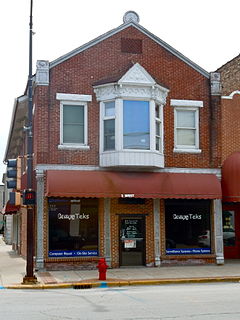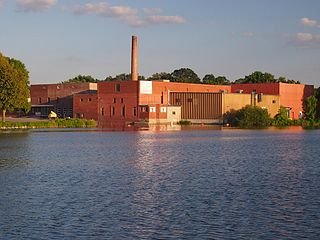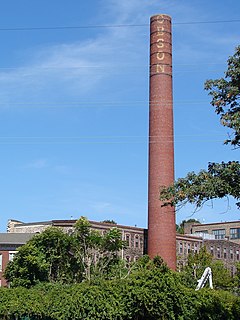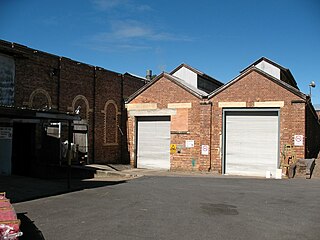
Thompsonville is a census-designated place (CDP) in the town of Enfield in Hartford County, Connecticut, United States. The population of the CDP was 8,577 at the 2010 census.

New Hartford is a town in Oneida County, New York, United States. As of the 2010 census, the town population was 22,166. The name of New Hartford was provided by a settler family from Hartford, Connecticut.

Damask is a reversible figured fabric of silk, wool, linen, cotton, or synthetic fibers, with a pattern formed by weaving. Damasks are woven with one warp yarn and one weft yarn, usually with the pattern in warp-faced satin weave and the ground in weft-faced or sateen weave. Twill damasks include a twill-woven ground or pattern.

Anatolian rug is a term of convenience, commonly used today to denote rugs and carpets woven in Anatolia and its adjacent regions. Geographically, its area of production can be compared to the territories which were historically dominated by the Ottoman Empire. It denotes a knotted, pile-woven floor or wall covering which is produced for home use, local sale, and export. Together with the flat-woven kilim, Anatolian rugs represent an essential part of the regional culture, which is officially understood as the Culture of Turkey today, and derives from the ethnic, religious and cultural pluralism of one of the most ancient centres of human civilisation.

The Greenwich Mills is an historic mill complex at 42 Ladd Street in Warwick, Rhode Island. The complex was developed between 1918 and 1927, and includes four brick structures. The oldest is the weave shed, a single-story structure built in 1918. The office building was built in 1919–20, and is a 3- and 4-story C-shaped structure. This building was designed by Providence architect T. Clarence Herrmann. The finishing mill, built in 1923 and expanded in 1931, is the largest of the complex, and is located at the corner of Blackmore and Ladd Streets. The dye house and boiler house is a single-story structure built in sections in c. 1922 and 1947. The mills were built on a site where industrial activity had been taking place since about 1836. The mills produced worsted wool fabric until 1950, and are now used for a variety of light industrial purposes.

The Bigelow Carpet Company Woolen Mills are a historic mill complex on Main Street in Clinton, Massachusetts. The sprawling mill complex was built or expanded by the Bigelow Carpet Company, one of Clinton's leading business for much of the 19th and early 20th centuries. The complex was listed on the National Register of Historic Places in 1983. It continues to be adaptivelry reused by smaller businesses.

Narragansett Mills is an historic textile mill site located at 1567 North Main Street in Fall River, Massachusetts, United States. Built in 1872, it is a well-preserved example of a brick mill complex, somewhat unusual in a city where most of the mills are stone. It was listed on the National Register of Historic Places in 1983.

Pilgrim Mills is an historic textile mill located at 847 Pleasant Street in Fall River, Massachusetts. The mill was built in 1911 from red brick and was the first mill in the city powered entirely by electricity, provided from the local grid. It was one of the last mill complexes built in the city. The property was listed on the National Register of Historic Places in 1983.

The Whittall Mills is an historic industrial complex in southern Worcester, Massachusetts. The complex, which was built between 1870 and 1930, is a reminder of the large carpet manufacturing business that was once a major presence in the city. It is a complex of 15 brick buildings located on a bend of the Middle River, south of Crompton Street and just west of Interstate 290.

The Item Building is a historic commercial building at 26 Albion Street in Wakefield, Massachusetts. Built in 1912, the single story brick building serves as the headquarters of The Wakefield Daily Item, Wakefield's main community newspaper, and is a well-kept example of early 20th century commercial architecture.

The Stolp Woolen Mill Store was built in 1860. It is located on Stolp Island in Aurora, Illinois. It was listed on the National Register of Historic Places in 1983. It is also a contributing building in the Stolp Island Historic District.

Kerman carpets are one of the traditional classifications of Persian carpets. Kerman is both a city and a province located in south central Iran, though the term sometimes describes a type which may have been made elsewhere. Kerman rugs are prized for a wide range of designs, a broad palette, use of natural dyes and fibers, great tensile strength and abrasion resistance, and expert color combinations. Typical manufacturing used an asymmetrical knot on cotton foundation, but rare examples include silk or part silk piles, or silk foundations with wool pile.

The Faribault Woolen Mill Company is a textile manufacturing company in Faribault, Minnesota, United States, that produces and sells wool blankets and other woolen products. Its products included ingeo, cotton, acrylic and wool bed blankets, pillows, mattresses, pads, and baby blankets, and wool, ingeo and blend throws. The company primarily serves various enterprise sectors. It offers its products through its store in Faribault and nationwide through retailers.

Dobson Mills is a historic industrial complex and national historic district located in the Hunting Park Industrial Area of Philadelphia, Pennsylvania. It encompasses 19 contributing buildings, 2 contributing sites, and 2 contributing structures. They were built between 1858 and 1928, and are primarily of heavy timber frame construction with load bearing masonry walls. They range from two to five stories in height. The complex included blanket, overcoat, and wool yarn production facilities, a carpet mill, and plush mill.

Irene Mill Finishing Plant, also known as the Cherokee Finishing Company, is a historic factory building located at Gaffney, Cherokee County, South Carolina, United States of America. The building was constructed in 1915–1916, and is a large, rectangular, one-story brick building with a gable roof with exposed support beams. Also on the property are two small, square brick structures with pyramidal roofs covered with pressed metal shingles. The mill produced damask which was shipped to New England for finishing. In the finishing plant the cloth was washed, soaked, boiled, bleached, and calendered, enabling the mill to produce finished damask products.

The Hillsborough Mills are a historic textile manufacturing complex at 37 Wilton Road in western Milford, New Hampshire, near its town line with Wilton. The oldest buildings of the brick mill complex were built in 1866 as a carpet-making operation. This business failed in 1874, but the complex was acquired by other textile interests, and eventual saw success producing carpet yarns, and blankets for horses and bedding. The mills were closed in 1970, and have since been adapted for other uses. The complex was listed on the National Register of Historic Places in 2014.

Queensland Woollen Manufacturing Company mill is a heritage-listed mill at 42 & 42B The Terrace, North Ipswich, City of Ipswich, Queensland, Australia. It is also known as Australian Fabric Manufacturers Ltd and Boral Hancock Plywood. It was added to the Queensland Heritage Register on 19 September 2008.

The Winsted Hosiery Mill, also known as the Whiting Mill, is an industrial complex at 210 Holabird Avenue in the Winsted section of Winchester, Connecticut. Developed in the late 19th and early 20th centuries, it was one of the largest industrial employers in the community for many years, and is relatively unaltered from its period of development. It was listed on the National Register of Historic Places in 1985. It is now subdivided for multiple industrial and commercial tenants.

The Bigelow-Hartford Carpet Mills were once one of the largest manufacturers of carpeting in the United States. The company's early 20th-century factories, located in Thompsonville, Connecticut, were listed on the National Register of Historic Places in 1983. Used by a succession of carpet makers until the 1960s, the company complex has for the most part been converted to residential use.

The Western Knitting Mills is a former industrial building located at 400 Water Street in Rochester, Michigan. The building has been renovated to serve commercial tenants, including Rochester Mills Beer Company. It was listed on the National Register of Historic Places in 2000.






















